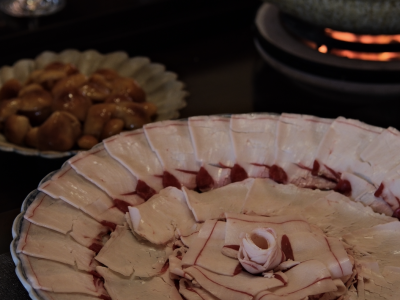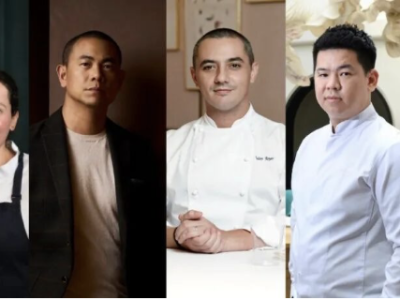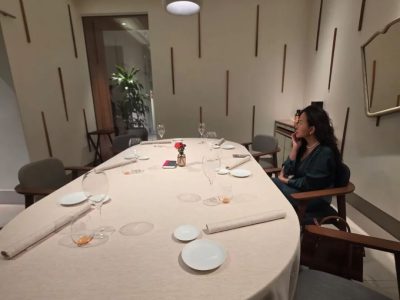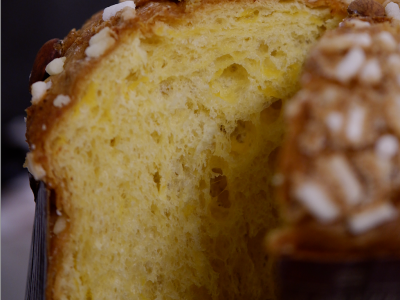Earlier this year, I was on the way from Shenzhen to Hong Kong on a Sunday afternoon to meet up with a good friend. Having not visited Hong Kong for a while, I realised that many restaurants there are closed on Sundays. For a long time, I've admired chef Mingoo Kang, owner of South Korea’s two Michelin-starred restaurant Mingles. His restaurant in Central, Hong Kong, which I've never had the chance to visit, was my destination for a relaxing and enjoyable dinner on that day.
@Jocelyn華姐's TastyTrip YouTube
Since its opening in 2020, Hansik Goo has been crowned a Michelin star. "Hansik" means Korean cuisine, while "Goo" represents Chef Mingoo Kang's innovative Korean dishes, aimed at offering a relaxed enjoyment of authentic modern Korean cuisine. The setting is spacious and bright with a warm ambiance. Interestingly, the building is home to many other Michelin-starred restaurants: The Chairman, Vea, and Wing. I said to myself that I should really stay longer next time I come to Hong Kong.
As soon as we sat down, the restaurant manager Lucas shared the concept of Hansik Goo and brought rounds of laughter to the group.
The dinner commenced with a caviar-adorned Korean perilla seedjuk (porridge), followed by a pairing of freshly sliced filet mignon, seasoned with soy sauce, honey, and sesame oil. Very fine Korean beef is complemented by a creamy egg yolk paste, offering a buttery texture, further elevated with the addition of truffle to enhance both aroma and mouthfeel.
The “Autumn Hweh” features seasonal squid and yellowtail, seasoned with Korean sancho pepper to offer a mild numbing sensation. Compared to Sichuan peppercorn, Korean sancho pepper is lighter in numbness but has a stronger citrusy note. The sashimi is paired with two-year aged kimchi to effortlessly awaken the taste buds.

Korean Starter
The "Gaesal Jatjeuptang" is composed of an array of components that showcase the best of autumnal produce, using snow crab and Koreanwanja (traditional Korean meatball) made from hairy crab meat and crab roe. This pairs seamlessly with the richness of pine nut sauce cooked with crab broth, further enhanced with the addition of Korean zucchini and eggnog to enrich the palate.
Next is the “GeumTae Gui”, which translates to grilled blackthroat seaperch fish in Korean. The fish is marinated ingochujang (fermented chili pepper paste), and grilled to bring out the flavour of the fat and paired with pickled gat (brown mustard greens) to cleanse the palate and surf clams sauteed with garlic chive.
Korean ginseng chicken is reconstructed here, with the breast meat grilled to a slight char while maintaining its juice. Paired with ginseng risotto and 25-head South African Yoshihama abalone, this is a dish I particularly loved when I dined at Mingles, still memorable even after years. It blends rich Korean flavours with innovation, very delicious even without using dried abalone – not sure if this is to cater to local palate, because Korean cuisine is already good at handling fresh abalone.
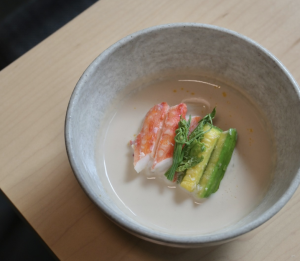
Gaesal Jatjeuptang
For the main course, “Hanwoo Bulgogi & Deoduk with Pyogo Mushroom Bab”, a nutritious combo that is both packed with flavours and fun to eat. The highest-gradehanwoo (Korean beef) is marinated in Korean soy sauce and pear juice then grilled to impart a delectable smokiness and served alongside deep-fried deodeok or the root of Lance Asiabell, a flowering plant native to East Asia. It is accompanied by pyogo mushroom rice cooked with a flavourful mushroom broth, Jerusalem artichoke, ginkgo, accompanied by a variety of banchan (small side dishes).
The dessert also serves as an adequate conclusion to the menu. With delicate seasoning, excellent use of ingredients, beautifully handled meat dishes like the grilled fish and Korean beef, Hansik Goo undoubtedly reflects the standards of a Korean fine Bistro. The service is warm and attentive, the atmosphere pleasant and relaxed.
Meaning “a family that shares meals together”, Hansik Goo offers delectable modern Korean cuisine in a laid-back, joyful ambience.
Author: Jocelyn 华姐
Photo: instagram@hansikgoo


